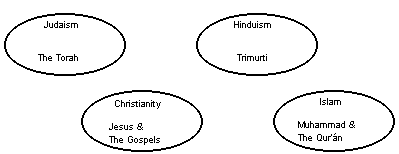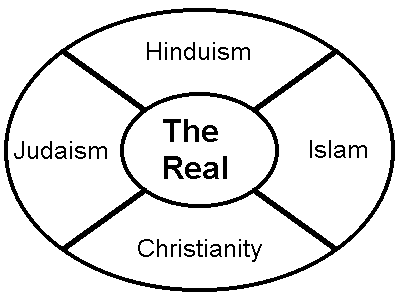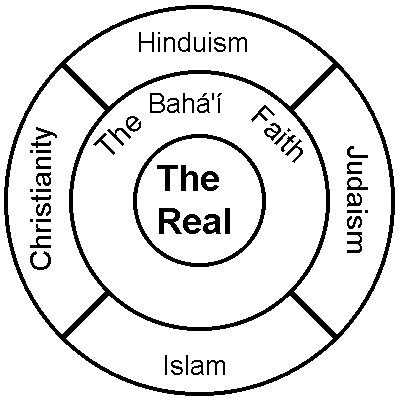
|
|
Abstract: The Bahá'í principal of unity in diversity as applied to religious pluralism. |
Bahá'í Faith and Religious Diversity
by Phillip Smith
published in Bahá'í Studies Review, 1:1London: Association for Bahá'í Studies English-Speaking Europe, 1991
There is a fear amongst many non-Bahá'ís, and an expectation amongst many Bahá'ís, that religious unity will be achieved by everyone abandoning their own religion and becoming a Bahá'í. This is unity but it may lead to a lack of diversity. If everyone were to become a Bahá'í, would it mean there be no more church services, no more Buddhist chants, or puja offered to Shiva? Would there be no more Christmas, Divali or Passover? Is a world where there are only obligatory prayers, nineteen day feasts and annual fasts really what Bahá'u'lláh is offering mankind? Is this unity in diversity or merely uniformity?
This paper is an attempt to begin to answer these questions and to see if there is a way that the Bahá'í Faith could bring about religious unity whilst retaining a colourful and enriching variety of religious expression. The first part of this task is to analyse the problem. Before exploring the question of how to unite the religions, the existing relationship between them must be addressed.
Religious Plurality
Traditionally each religion has been seen as a distinct system with its own unique central focus (see fig.1). Thus Christianity is seen as emanating from the central doctrine of the incarnation.of Christ as revealed in the gospels. Islam revolves around the Qur'an and the exemplary life of Muhammad. The varieties of Hinduism are united in devotion to one of the aspects of the Trimurti. Seen in this way the task of uniting the religions appears to be impossible because the central features of each appear to be irreconcilable with all the others.

Figure 1: Religions seen as separate belief systems.
In addition we have the confusing assertion by Bahá'ís that all religions are equal. If all of them are equally right why should the Bahá'ís try to unite them as it will make no difference which religion people follow? If, however, the Bahá'í Faith is more right, because it is more recent, how can the faiths be united except by getting people to leave their old religions and be absorbed by the Bahá'í Faith? Can the creation of one "super- religion" made up of ex-Christians, ex-Buddhists and ex-Muslims really be called a unification of religions? Surely this is the way that Christians and Muslims already dream of uniting the religions, by converting everyone to theirs. The Bahá'ís would appear to simply be making a rival bid to be the world's "super-religion."
This problem of the plurality of religions, each making its own unique truth-claims, is one that Christian theologians have been struggling with for most of this century. It has long been recognised by them that the difficulty that has been encountered in providing a solution may well be due to a defective analysis of the original problem and so in recent years much attention has been given by theologians to the attempt to establish a "world theology" rather than a merely Christian one.
Religious Diversity.
John Hick, one of the leading thinkers in this field, has proposed a "Copernican revolution" in the way we regard religions. Instead of seeing each religion as a separate belief system, he proposes that each should be seen as a response to a transcendent reality. All people in all ages have had experience of this transcendent (which he terms the Real) but they have had to interpret the experience according to the culture to which they belonged. The function of religion is to give people a belief- structure to help them understand this experience and to provide a framework within which they can respond to it.
- Experience of the transcendent is structured either by the concept of deity, which presides over the theistic traditions, or by the concept of the absolute, which presides over the nontheistic traditions. Each of these is schematised in actual human experience to produce the experienced divine personas (such as Jahweh, the heavenly Father, Allah, Vishnu, Shiva) and metaphysical impersonae (such as Brahman, the Tao, the Dharmakaya, Sunyata) to which human beings orient themselves in worship or meditation. (Hick, Interpretation 14)
Seen in this way, religions cease to be separate and rival systems, and become merely diverse ways of responding to the same Reality (see fig.2). Apparently contradictory truth-claims become different ways of interpreting and responding to the Real. In one sense the religions become united, all sharing the same central focus.

Figure 2: Religions seen as responses to transcendent Reality.
- There can be no doubt whatever that the peoples of the world, of whatever race or religion, derive their inspiration from one heavenly Source, and are the subjects of one God. The difference between the ordinances under which they abide should be attributed to the varying requirements and exigencies of the age in which they were revealed. (Bahá'u'lláh, Gleanings 217)
In the Bahá'í teachings all religions are seen as God-centred and the founders of all of them as being equal Manifestations of God. Thus the Bahá'í way of resolving the problem of the plurality of religions is very similar to that of Hick. Indeed, it could be argued that this is the fundamental insight that Bahá'u'lláh brought to mankind in order to unite the religions. Once this is recognised the religions cease to be separate and rival systems but simply become different denominations of the same faith. The barriers between religions can come down and the various communities join together in shared worship of the one God.
- All must abandon prejudices and must even go into each others churches and mosques, for in all worshipping places, the Name of God is mentioned. Since all gather to worship God, what difference is there? ('Abdu'l-Bahá, Star of the West vol ix, no.3, p.37)
As Moojan Momen has made clear, Bahá'u'lláh even solved the apparent contradiction between the different ways that the religions describe what Hick refers to as the Real. In Western religions it is referred to in the personal concept of "God" while eastern religions conceive of it as an impersonal "Brahman" or "Nirvana". In His writings Bahá'u'lláh refers to God in both personal and impersonal terms seeing no contradiction between them. Rather each is seen as an equally inaccurate human way of trying to describe that which is beyond understanding.
- Therefore, no absolute knowledge of the cosmos being available to man, all descriptions, all schemata, all attempts to portray the metaphysical basis of the universe, are necessarily limited by the viewpoint of the particular person making them. They are limited, relative truths only. (Momen, Studies 200)
Thus the contradictions between Eastern and Western metaphysics are not seen as rival truth-claims, where to affirm one would be to negate the other, but merely as different ways of viewing the one Reality. It can be seen that Hick's "Copernican revolution" in the way of looking at religions is not revolutionary to Bahá'ís alone. However, the question still remains as to how the Bahá'ís believe these differing religions will be united and how the Bahá'í Faith relates to them. Even with our new analysis of the problem, the question of how unity can be achieved without eradicating the diversity is still not answered.
Uniting the Religions.
On Hick's model unity could be achieved in two main ways. Firstly, all the existing religions could accept that they are all God-centred and carry out ‘Abdu'l-Bahá's instruction to go into each other churches. This would take the form of an ecumenical movement between religions. Individual differences due to taste and cultural tradition would be preserved but there would be a recognition of their fundamental unity and equality as well as an increase in shared acts of worship. However, this could be achieved without the existence of the Bahá'í Faith.
Admittedly Bahá'ís could argue that Bahá'u'lláh's teachings are needed to provide the inspiration and insight to arouse the inter-faith movement but it is not necessary for Him to found a religion. His teachings may not even be necessary. Hick seems to have constructed a valid philosophical model for religious unity without reference to Bahá'u'lláh and, perhaps, with no knowledge of Him. There seem to be many others working within the inter- faith community who believe that religious tolerance and unity can be achieved without the help of a 'nineteenth-century Persian mystic'.
However, Bahá'ís know that Bahá'u'lláh did found a new religion, with a new calendar, its own holy days, its own scriptures and its own devotional practices. This leads to the second way that unity could be achieved on Hick's model. If the Bahá'í Faith becomes yet another religion, existing alongside the others as just another response to the Real, then the only way it can unify the religions is by conversion; by growing and absorbing the other religions. If this is really what Bahá'u'lláh meant to happen then the Bahá'í Faith becomes a form of religious imperialism.
As this is so much in contrast to Bahá'u'lláh's teachings about about racial and world unity, I cannot believe it is what He intended. The solution, I believe, lies in seeing that the Bahá'í Faith is fundamentally different to the other world religions and is not just a new religion existing alongside the older ones, or even a new one come to replace the old ones. The way that unity will be achieved, I believe, could be by all the religions accepting Bahá'u'lláh and the Bahá'í laws but retaining much of their own unique religious traditions and expressions.
Bahá'í Religious Unity.
When somebody becomes a Bahá'í it is a very different process to when a person converts to any other religion. William Garlington, when studying mass conversions from Hinduism to the Bahá'í Faith in Malwa, India (see Garlington, in Studies) compared them to earlier mass conversions to Christianity, Buddhism and Islam. He found that converts were forced in these earlier conversions to renounce or even disparage their earlier beliefs. However, those who declared a belief in Bahá'u'lláh were not required to negate or devalue Hinduism, merely to recognise that it was a divinely inspired religion in need of regeneration.
- By not forcing an individual to denounce his Hindu heritage, the Bahá'ís allow him to remain, psychologically speaking, a Hindu; he is a Hindu who believes in the Yugavatar, Bahá'u'lláh. . . . If the above is true, one might question whether the term convert can be appropriately used to refer to those villagers who declared their belief in Bahá'u'lláh. (Garlington, Studies 174)
The word "convert" is usually used to refer to those people who move completely out of one religious tradition and into another. This is not necessary for those that become Bahá'ís because of the belief that Bahá'u'lláh is the promise of all ages and fulfils the adventist prophecies of all the major religions.
- Thus Shoghi Effendi referred to Bahá'u'lláh as being the messianic figure expected by not only Judaism, Christianity, Islam and Zoroastrianism, but also Hinduism and Buddhism. More recently, Bahá'í writers have extended their polemic to attempt to prove, for example, that the Bahá'í Faith fulfilled the millenarian expectations of Buddhists, Mormons and North American Indians. (Smith, Religions 144)
Thus, anyone who becomes a Bahá'í accepts Bahá'u'lláh as the fulfilment of their previous religion, not as someone who established a rival to it. What is more, although Bahá'u'lláh established new liturgical practices and revealed his own scriptures, he did not abrogate all previous religious practices and confirmed the divine authority of all previous scriptures. A person who becomes a Bahá'í, as long as they keep the Bahá'í laws, can, therefore, not only retain a psychological link with their past beliefs but are free to continue to read their previous holy books and, as far as I am aware, to use earlier prayers and forms of religious expression.
What they are not permitted to do is to remain as members of their previous religion. Shoghi Effendi instructed Bahá'ís in 1935 that they could not be members of other religious bodies, except for general bodies such as the World Congress of Faiths. This referred to membership of the administrative part of any other religion. It would make little sense for a Bahá'í to be a member of a body that sought to maintain or spread the teachings of the Christian Church, or any religion other than the Bahá'í Faith. Bahá'ís must be exclusively committed to the Bahá'í administrative system but there appear to be no instructions from Shoghi Effendi to exclude Bahá'ís from taking part in, or using, earlier religious forms of expression.
I contend that this reveals that the Bahá'í Faith is indeed a very new form of religion and that in order to understand its relationship to other religions we need to amend our earlier diagrams drawn to illustrate Hick's views (see fig. 3). If the Bahá'í Faith becomes the only, or even the most dominant, religion in the world then it will not exist alongside earlier religions or absorb them. It will be an addition to earlier religions, and by the adoption of Bahá'í religious teaching and practice the believer will be moved closer to, or put more clearly in touch with, the Real. This process will inevitably lead to a revision of previously held beliefs, and the rejection or adaptation of some earlier practices, but will not necessarily lead the rejection of them all in favour of exclusively Bahá'í ones.
This would mean that as long as Bahá'ís keep the Bahá'í laws such as fasting, reciting the obligatory prayers revealed by Bahá'u'lláh and abstaining from alcohol, as well as attending Bahá'í Feasts and observing the holy days, they could also continue with any earlier religious practices that they found spiritually enriching.

Figure 3: The Bahá'í Faith uniting the religions.
Of course there will be many who will find the Bahá'í scriptures and devotional practices enough for their spiritual needs and who will not wish to retain or explore the varieties of religious expression from the past. But there will also be others who will wish to maintain religious traditions that are important to their cultures or will wish to draw spiritual nourishment from acts and expressions of religious devotion from the past. I am suggesting that in the future both of these groups could be considered to be Bahá'ís, and to be equally true, loyal and devoted Bahá'ís.
Summary.
To summarise I would state that the great aim of the Bahá'í Faith is unify the world's religions without imposing religious uniformity. Although there would be doctrinal conformity and administrative cohesion there would always be freedom of religious expression according to the tastes and culture of the individual.
The first stage is the recognition that each religion is responding to and centred upon the one divine Reality. This is the stage that Hick and many modern theologians are now coming to. However, for Bahá'ís this is not enough, and true unity will only come about when each religion acknowledges that they are fulfilled and regenerated through the person and teachings of Bahá'u'lláh. As I have tried to establish in this paper, this will not mean that the previous religions are abandoned or denigrated in any way. The teachings and laws of Bahá'u'lláh are an affirmation of and an addition to those of the founders of previous religions, not a replacement of them. Although the previous teachings and practices will need to be reviewed and may need to be revised in the light of Bahá'u'lláh's message, they will not be abandoned. The best of them will be preserved in a world which will be united in worship of the one divine Reality but where there will still be diversity of response to it according to individual, cultural and traditional needs.
Works Cited
‘Abdu'l-Bahá. Star of the West. Vol ix. Reprinted Oxford: George Ronald, 1978.
Bahá'u'lláh. Gleanings form the Writings of Bahá'u'lláh. Trans. Shoghi Effendi. 2d. ed. Wilmette: Bahá'í Publishing Trust, 1976.
Garlington, W. "Bahá'í Conversions in Malwa, Central India." in From Iran East and West: Studies in Babi and Bahá'í History, v. 2. ed. by J.R. Cole and M. Momen. Los Angeles: Kalimat Press, 1984.
Hick, J. An Interpretation of Religion. Basingstoke: Macmillan Press, 1989.
Momen, M. "Relativism: A Basis for Bahá'í Metaphysics" in Studies in Honor of the Late Hasan M. Balyuzi: Studies in the Babi & Bahá'í Religions, v. 5. ed. by M.Momen. Los Angeles: Kalimat Press, 1988.
Smith, Peter. The Babi and Bahá'í Religions. Cambridge: Cambridge University Press, 1987.
|
|